Rabbits and hares look similar to each other, but the key difference between a hare and rabbit is their physical appearance. In this article, you will effortlessly get to know about five differences between rabbits and hares.
Top 5 Differences Between Rabbits And Hares
Here, we have shortlisted a few of the difference between hare and rabbit that’ll help you to differentiate between the hares and rabbits easily.
Baby Hare Vs Rabbit
Baby hares, also known as leverets, are born with a remarkable level of independence. Their ability to survive on their own shortly after birth is due to their well-developed senses and physical capabilities. This early maturity allows them to adapt to their environment and evade potential predators quickly.
Baby rabbits, also known as kits or kittens, are born hairless, blind, and completely dependent on their mothers for survival.
During the first eight weeks of their lives, they rely on their mother’s care and attention for warmth, nourishment, and protection. This period is critical for the development of their senses and physical abilities as they gradually grow fur and open their eyes.
The Hare Vs Rabbit Size And Speed
Hares and rabbits belong to the same family, but there are some distinct difference between a rabbit and a hare.

Hares are larger than rabbits, with longer ears and legs, adapted for living in open spaces like prairies. Their larger size and longer limbs make them faster runners, essential for evading predators in their natural habitat.
Rabbits tend to live in more sheltered environments. They have also evolved to be smaller and more agile in navigating thick vegetation.
The difference in size and speed between hares and rabbits is a result of their distinct environmental functions. Rabbits and hares do have different diets, reflecting their distinct feeding habits.
Moulting Process Between Hares And Rabbits
Hares and rabbits both undergo moulting, but hares generally exhibit more dramatic seasonal colour changes compared to rabbits. The snowshoe hare transitions from brown to a brilliant white coat in winter to blend in with the snowy environment.
This adaptation provides an effective disguise during the winter months, helping them evade predators and hunt for food more effectively.

Rabbits also moult; their colour changes are typically less dramatic than those of hares. This difference in seasonal colour change is an evolutionary adaptation that allows hares to flourish in their specific habitats and survive harsh winter conditions.
Colour variation between moults is generally much less noticeable in the case of rabbits than in other animals. Rabbits typically moult their fur twice a year, and while there may be some subtle changes in colour during this process, it is not as pronounced as in other animals.
Food Of Rabbit Vs Hare
Rabbits tend to prefer grasses and vegetables with leafy tops, such as carrots. Hares lean towards harder substances like plant shoots, twigs, and bark. These digestible preferences are a result of their differing habitats and lifestyles.

Rabbits typically live in burrows and rely on quick bursts of speed to evade predators, so their diet is more focused on easily reachable vegetation.
Hares are more adapted to open spaces and rely on their agility and disguise for protection. It allows them to consume more challenging plant materials.
It is not a good idea to give rabbits chicken eggs because they can upset their stomachs. It’s safest to avoid feeding eggs to bunnies to prevent any potential harm.
Homes Of Rabbit Vs Hare
Rabbits and hares have different preferences when it comes to their choice of homes. Wild European rabbits are known for living in complex burrow systems called warrens, which can be quite extensive, reaching depths of up to nearly 10 feet and lengths of almost 150 feet.

These warrens provide protection and shelter for the rabbits, allowing them to navigate through a complex network of tunnels. Eastern cottontail rabbits are found across a wide range from southern Canada to northern South America. They often live in tunnels that other species, such as woodchucks, have borrowed.
Hares are known for living above ground and creating their homes in various ways. They are adept at finding shelter in hollow log burrows or by making simple nests in dense vegetation.
Hares Are More Like Hermits
Hares and rabbits have different social behaviours. Rabbits tend to live in large groups known as colonies. Hares are typically solitary creatures.
During late winter and for courting purposes, hares may come together temporarily. This behaviour contrasts with the more sociable nature of rabbits, who often live in groups of up to 20 individuals.
The eastern cottontail rabbit is an exception to the general trend of hare solitude, as it exhibits a more sociable nature similar to its rabbit cousins.
Bunnies, rabbits, and hares are all part of the same family called Leporidae, but they have some differences that are given below.
Bunny Vs Rabbit Vs Hare
Bunnies are young rabbits, usually less than a year old. They’re known for their small size and adorable appearance. Rabbits are larger than bunnies and can be domesticated as pets. They have long ears and powerful hind legs for hopping.

Hares are wild animals with longer legs and bigger bodies compared to rabbits. They also have black markings on their fur and don’t dig burrows like rabbits do. Hares are known for their incredible speed and agility, making them adept at escaping predators in the wild. Bunnies and rabbits may seem similar, but hares have distinct physical characteristics that set them apart from both bunnies and rabbits.
What Is The Difference Between A Giant Rabbit And A Hare?
Giant rabbits are domesticated breeds of rabbits that have been selectively bred to be larger in size compared to wild rabbits. They are typically kept as pets and can weigh up to 20 pounds or more. Hares are wild animals that belong to the genus Lepus and are known for their long ears and powerful hind legs. They are generally larger than rabbits and have different behaviors and habitats.
The main differences between a giant rabbit and a hare lie in their size, domestication status, and behavior. Giant rabbits are bred for their large size and kept as pets, while hares are wild animals with distinct physical characteristics and behaviors adapted for survival in the wild.
Conclusion:
The differences between rabbits and hares may appear similar at first glance, but several key differences distinguish the two species. From their physical characteristics and habitat preferences to their behaviour and reproductive strategies, rabbits and hares reveal unique characteristics that set them apart.
By recognizing these distinctions, we can better appreciate and protect both rabbits and hares as essential components of our environment. The overall distinction between the social behaviours of hares and rabbits remains clear, with hares being more solitary and rabbits tending to form larger groups or colonies.
FAQ’s
What Does A Hare Eat?
Hares are herbivorous animals, which means they primarily eat plants. Their diet consists of a variety of grasses, herbs, and leaves. They also enjoy nibbling on twigs, buds, and bark from small shrubs and trees. They may also consume fruits and vegetables when available.
Are Rabbits And Hares The Same?
Rabbits and hares may look similar, but they are actually different animals. The main difference is in their physical appearance. Rabbits typically have shorter ears and legs, while hares have longer ears and legs. Rabbits live in burrows and are more social, while hares prefer to live above ground and are more solitary.
How To Litter Train A Rabbit?
Training a rabbit to use a litter box is similar to training a cat. Begin by putting the litter box in the area where your rabbit usually goes to the bathroom, using safe litter like paper-based or wood pellets. Introduce your rabbit to the box by placing some droppings inside and rewarding them for using it.
Are Hares More Social Than Rabbits?
Hares are larger and heavier than rabbits, with longer legs and ears that help them navigate their habitat more efficiently. These adaptations make hares well-suited for living in open spaces where they need to run quickly to escape predators.
- Chicken Pecking Order: Top Secrets Of Chicken Flocks (2024) - May 26, 2024
- Top 5 Differences Between Rabbits and Hares - May 25, 2024
- 9 Edible Weeds Likely Growing in Your Yard (2024) - May 23, 2024

